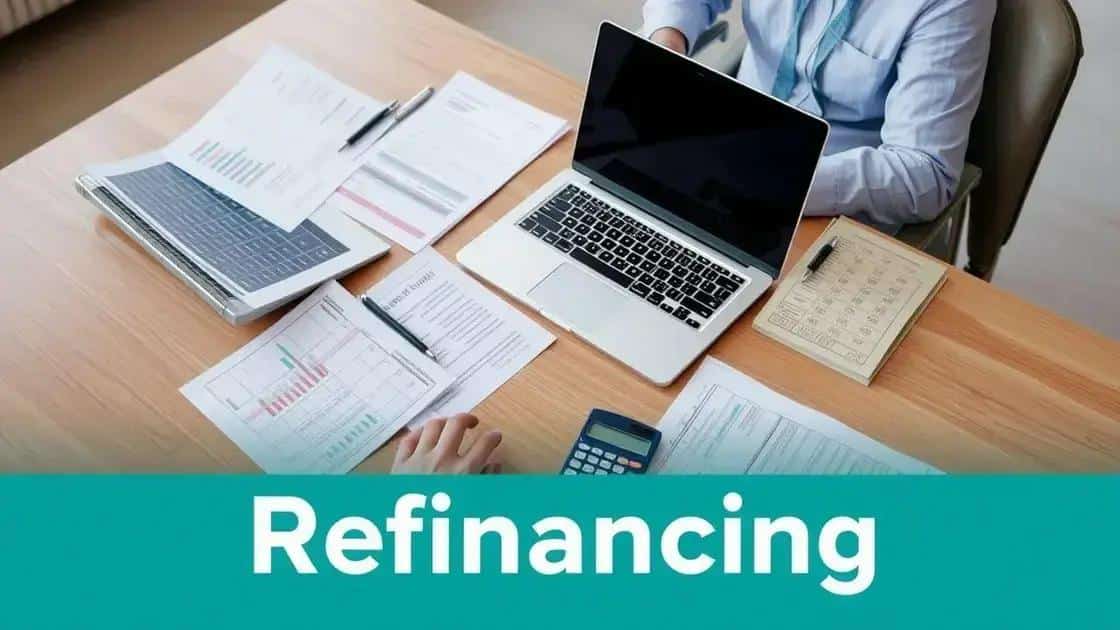Debt refinancing: is it the right choice for you?

Anúncios
Debt refinancing involves taking out a new loan to repay existing debt, often to secure lower interest rates or better terms, but it carries risks like fees and longer payment periods.
Debt refinancing can be a smart financial move if you’re looking to improve your loan terms. But how do you know if it’s right for you? In this article, we’ll break down the essentials and help you decide.
Anúncios
Understanding debt refinancing
Understanding debt refinancing is essential for anyone looking to manage their finances better. It involves replacing an existing debt obligation with a new one, often with different terms. This can lead to lower interest rates, reduced monthly payments, or even a different loan term altogether.
Anúncios
What is debt refinancing?
Debt refinancing simply means taking out a new loan to pay off an existing one. This option can be beneficial if the new loan offers better interest rates or improved terms. For example, if your credit score has improved since you first took out a loan, you might qualify for a much lower rate.
Benefits of refinancing
When considering refinancing, it’s essential to know the potential benefits:
- Lower interest rates: This can save you money in the long run.
- Reduced monthly payments: A lower rate means you might pay less each month.
- Access to cash: Some refinancing options allow you to take cash out against the equity of your home.
- Better loan terms: You might switch from a variable-rate loan to a fixed-rate loan for stability.
However, refinancing isn’t always the right choice. It’s crucial to evaluate the costs associated with the new loan against the potential savings. Closing costs and fees can sometimes negate the benefits.
Another important factor is your current loan’s terms. If you’re very close to paying it off, refinancing might extend the life of your debt, which could cost you more in interest over time.
In conclusion, understanding your options for debt refinancing is key to making a sound financial decision. Analyze the benefits and drawbacks based on your unique situation to determine the best path forward.
When should you consider refinancing?

Deciding when to consider refinancing your debt is crucial for your financial health. While refinancing can provide many benefits, it is not always the right choice. Understanding the right time to make this financial move can lead to better long-term outcomes.
Key factors to consider
Several factors can help you determine when it’s the right time to refinance. First, if you notice that interest rates have significantly dropped since you took out your original loan, it may be advantageous to explore refinancing options. A lower interest rate could mean lower monthly payments or reduced overall interest paid.
Understanding your financial situation
Your current financial situation is also a determining factor. Considering a refinance might be a good idea if your credit score has improved since you first took out the loan. A higher credit score usually qualifies you for better interest rates. This change can lead to significant savings. Additionally, if you’re struggling to make your monthly payments, refinancing to a longer term might ease your financial burden.
- Before a rate increase: If rates are expected to rise soon, act quickly to lock in a lower rate.
- Improved credit score: A better score can unlock better loan terms.
- Financial hardship: If you’re facing difficulties, refinancing might offer relief.
- Shortening your loan term: If you can afford higher payments, refinancing into a shorter term can save you on interest.
As you consider refinancing, it’s essential to weigh not just the benefits but also the costs. Take into account any fees or prepayment penalties that might come into play. Always do your research and possibly consult a financial advisor to gain insights tailored to your circumstances.
Being informed about when to consider refinancing can lead to smarter financial decisions. Timing is everything in finance, and staying aware of the market trends is key.
How to evaluate refinancing options
Knowing how to evaluate refinancing options is vital for anyone looking to improve their financial situation. With so many choices available, making an informed decision can significantly impact your financial health. Start by understanding the different types of refinancing available and how they fit your needs.
Assess your financial goals
Before diving into the options, you should assess your financial goals. Determine whether you want to lower your monthly payments, reduce interest rates, or maybe tap into your home’s equity. This will guide you toward the right refinancing products.
Compare interest rates
Next, you’ll want to compare interest rates from various lenders. Getting quotes from multiple sources can provide a clearer picture of what’s available. Look for the Annual Percentage Rate (APR), as it reflects the total cost of borrowing.
- Check lender fees: Pay attention to the fees associated with each lender. Some might have lower interest rates but higher fees.
- Look at loan terms: Decide whether a 15-year or 30-year term suits you better based on your financial goals.
- Consider the type of loan: Fixed or adjustable rates will affect your payments differently over time.
- Review the fine print: Make sure to read all terms and conditions to understand what you’re signing up for.
Once you have this information, calculate your potential savings. Use online calculators to see how much you could save with different refinancing options. Take into account your current loan balance and the new interest rates offered. This can help you visualize the long-term effects on your finances.
Finally, consult with a financial advisor if you’re unsure which path to take. A professional can provide personalized insights based on your financial situation and help you weigh your options carefully. Understanding how to evaluate refinancing options is essential for making the best choice for your financial future.
Steps to refinance your debt

Refinancing your debt can seem overwhelming, but understanding the steps to refinance your debt makes the process much easier. Knowing what to expect helps you feel more confident and ready to tackle your financial goals.
Gather your financial documents
The first step is to gather all necessary financial documents. You’ll need information about your current debt, including loan statements, payment history, and any other relevant documents. This paperwork is crucial for lenders to evaluate your application.
Check your credit score
Next, it’s important to check your credit score. Lenders will consider your score when deciding on your refinancing options. A higher credit score usually results in better interest rates. If your score needs improvement, consider taking steps to enhance it before applying.
- Pay down debts: Reducing credit card balances can help improve your score.
- Make payments on time: Timely payments show lenders that you’re responsible.
- Limit new accounts: Avoid applying for new credit before refinancing.
Once your documents are ready and your credit score is checked, shop around for lenders. Different lenders offer various products and rates, so comparing options is essential. Look for competitive rates and favorable terms that align with your goals.
Apply for refinancing
After selecting a few lenders, complete the application process. Provide the required information and be honest about your financial situation. Lenders will perform a credit check and verify your financial details. Expect to answer questions about your income and debts.
Review the loan offer
When the lender makes an offer, be sure to review it closely. Check the interest rate, monthly payment, and loan term. Understand the fees and closing costs associated with the new loan. If everything looks good, you can move forward with the refinancing process.
Finally, sign the paperwork and close the loan. This step finalizes the refinancing process, and your old loan will be paid off with the new one. Ensure you understand the terms and feel comfortable with your decision.
By following these steps to refinance your debt, you can navigate the process more smoothly. A well-planned approach can lead to better financial outcomes and less stress.
Potential pitfalls of refinancing
While refinancing can offer many benefits, it’s essential to be aware of the potential pitfalls of refinancing. Understanding these risks helps you make informed decisions that align with your financial goals.
High fees and costs
One major pitfall is the fees associated with refinancing. Many loans come with closing costs that can be significant. If you aren’t careful, these costs can outweigh the potential savings you might achieve with a lower interest rate.
Longer loan terms
Refinancing can sometimes lead to longer loan terms. While this might lower your monthly payments, it can increase the total amount of interest you pay over time. Before committing to a new loan, consider how extending the term impacts your overall financial picture.
- Evaluate your current loan: Understand how much time you have left on your existing loan.
- Consider your budget: Make sure you can comfortably afford any new payments.
- Clarify the terms: Be clear on how a longer term will affect your total debt.
Another potential pitfall is locking in a rate that is higher than market rates. Interest rates fluctuate, and waiting too long can lead to missed opportunities for better rates. Always compare offers from multiple lenders to ensure you’re getting the best deal possible.
Credit score impact
Refinancing might have a temporary impact on your credit score. When you apply for a new loan, lenders perform hard inquiries, which can lower your score slightly. It’s essential to consider this if you plan to apply for other financing soon.
Sometimes, refinancing can lead to a higher monthly payment if you don’t select the right product. If you only focus on lowering your interest rate without considering the long-term implications, you might end up in a worse financial position.
Overall, staying aware of the potential pitfalls of refinancing can help you navigate the process more effectively. By recognizing these challenges, you can make better financial choices that lead to stable, long-term success.
In summary, refinancing can be a smart choice if used correctly. It offers the potential for lower interest rates and reduced monthly payments, but it comes with risks. By understanding when to refinance, evaluating your options carefully, and being aware of the potential pitfalls, you can make informed decisions that support your financial goals. Always consider your specific situation and consult with professionals if needed. Being proactive and educated about refinancing can lead to greater financial stability and success.
FAQ – Common Questions About Debt Refinancing
What is debt refinancing?
Debt refinancing is the process of taking out a new loan to pay off an existing one, often with better terms.
When should I consider refinancing my debt?
You should consider refinancing if interest rates have dropped or your credit score has improved since you took out your original loan.
What are some risks associated with refinancing?
Some risks include high fees, longer loan terms, and the potential negative impact on your credit score.
How can I evaluate my refinancing options?
You can evaluate options by comparing interest rates, considering lender fees, and assessing your overall financial goals.